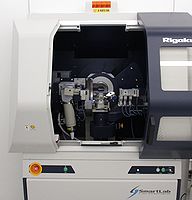Specific Process Knowledge/Characterization/XRD/XRD SmartLab
Feedback to this page: click here
XRD SmartLab
The Rigaku SmartLab is an advanced XRD for measuring on thin films. All thin films can be measured without fixating the sample, as the system has a so called In-Plane arm.

The user manual(s), user APV(s), technical information, and contact information can be found in LabManager:
Various measurement types including X-Ray reflectivity, Rocking curve, Theta-2theta, and Pole figures are described here:
The measurement settings and results of the pre-acceptance test are described in this document, also found on the Cleanroom drive:
File:SmartLab_Report_DTUv1.pdf
Software for analysis
The software packages used for data analysis are available on the equipment computer, but we recommend that you install it on your personal computer. To run the software you need a USB dongle with a license on, these can be borrowed from the equipment responsible (in 2020, these were Kristian, Evgeniy, and Rebecca). We only have 9 dongles available, so when you are done please return the dongle to Nanolab.
The software can be found on "CleanroomDrive\_Equipment\XRD\Rigaku software\RILauncher", it should be possible to install the software without a dongle. To use the software you have to log in. The user is: Administrator. There is no password.
| Equipment | XRD SmartLab | |
|---|---|---|
| Purpose | Crystal structure analysis and thin film thickness measurement |
|
| X-ray generator |
Maximum rated output |
3 kW |
|
Rated tube voltage |
20 to 45 kV | |
|
Rated tube current |
2 to 60 mA | |
|
Type |
Sealed tube | |
|
Target |
Cu | |
|
Focus size |
0.4 mm x 8 mm (Line/Point) | |
| Goniometer |
Scanning mode |
incident / receiver coupled or independent |
|
Goniomenter radius |
300 mm | |
|
Minimum step size |
0.0001° (0.36") | |
|
Sample stage |
| |
|
Sample size |
Diameter: 150 mm Thickness: 0~21 mm | |
| Optics | Incident side |
|
| Receiver side |
| |
| Substrates | Substrate size |
up to 150 mm wafers |
| Allowed materials |
All materials | |
Characterization of thin films using X-ray reflectivity (XRR)
Implementing the XRR method the user can calculate thickness, density, and roughness of the deposited material. The XRR is also widely employed for multilayer stack analysis.
Here are some results available:
- Characterization of e-beam deposited Al thin films.
- Characterization of ALD deposited Al2O3 and TiO2 ultrathin layers.
